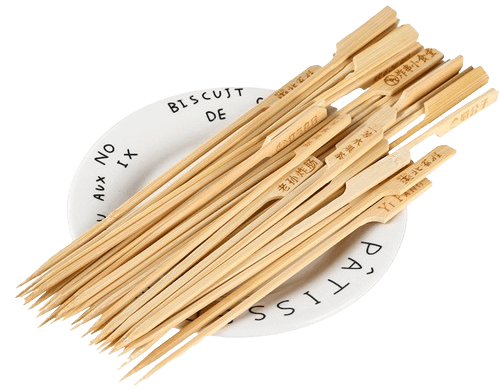At Ecostix Global, our mission is to revolutionize the way the world sees bamboo products. We strive to create high-quality, sustainable bamboo chopsticks and sticks that are not just utensils but symbols of a more eco-conscious lifestyle. Our focus is on blending traditional craftsmanship with modern innovation to produce items that are both environmentally friendly and aesthetically pleasing. Our goal is to foster a world where sustainability is not a choice but a natural way of living, ensuring a healthier planet for future generations.
Key Takeaways
| Question | Answer |
|---|---|
| Are chopsticks hard to use? | With practice and proper technique, chopsticks can be easy and enjoyable to use. |
| What are the types of chopsticks? | Chopsticks vary by material (bamboo, metal, plastic), shape, and size, and differ across cultures (Japanese, Chinese, Korean). |
| What is the basic holding technique? | Hold one chopstick like a pencil and the other between your thumb and forefinger. Practice is key. |
| What are common mistakes? | Holding chopsticks too tightly, incorrect finger positioning, and lack of practice. |
| How can I improve my chopstick skills? | Practice basic techniques, learn from videos, and understand cultural etiquette. |
Understanding Chopsticks
History and Cultural Significance
Chopsticks have a rich history that dates back over 5,000 years. Originating in China, these utensils quickly spread across Asia, becoming integral to various cultures. Chopsticks are not just tools for eating; they are deeply embedded in the traditions and etiquette of countries like Japan, Korea, and China. Each culture has its own unique style and usage, reflecting its heritage and culinary practices.
Different Types of Chopsticks
Chopsticks come in various materials, shapes, and sizes. The most common types include:
- Bamboo Chopsticks: Eco-friendly and traditional, bamboo chopsticks are lightweight and biodegradable. They are perfect for daily use and special occasions alike.
- Metal Chopsticks: Often made from stainless steel or titanium, these chopsticks are durable and reusable, ideal for modern dining.
- Plastic Chopsticks: Lightweight and colorful, plastic chopsticks are great for children and casual dining.
Different cultures have their own unique styles of chopsticks:
- Japanese Chopsticks: Shorter and tapered, often with intricate designs.
- Chinese Chopsticks: Longer and thicker, suitable for family-style dining.
- Korean Chopsticks: Flat and often made from metal, paired with a spoon for a complete dining set.
Getting Started with Chopsticks
Basic Holding Technique
Mastering chopsticks starts with the correct grip. Here’s a step-by-step guide:
- Hold the First Chopstick: Place the first chopstick between your thumb and the side of your ring finger. This chopstick remains stationary.
- Hold the Second Chopstick: Hold the second chopstick like a pencil, using your thumb, index finger, and middle finger.
- Practice Movements: Move the top chopstick up and down while keeping the bottom chopstick stationary. Practice picking up small objects to improve your dexterity.
Common Mistakes to Avoid
- Holding Chopsticks Too Tightly: This restricts movement and causes discomfort. Hold them loosely for better control.
- Incorrect Finger Positioning: Ensure the chopsticks are correctly positioned between your fingers for maximum efficiency.
- Lack of Practice: Like any skill, using chopsticks requires practice. Consistent use will lead to improvement.
Video Demonstration
For a more comprehensive understanding, check out our video tutorial on mastering chopsticks. Watching experts can significantly enhance your learning experience.
Techniques for Mastery
Basic Techniques for Beginners
Start with these fundamental techniques:
- Picking Up Food: Begin with larger pieces of food, gradually moving to smaller items as you become more comfortable.
- Transferring Food: Practice transferring food from one plate to another to improve your control and precision.
Advanced Techniques
Once you are comfortable with the basics, try these advanced techniques:
- Handling Slippery Foods: Use a firm but gentle grip to pick up slippery foods like tofu or noodles.
- Using Chopsticks for Different Cuisines: Adapt your technique based on the cuisine, such as handling sushi, noodles, or rice.
Practical Tips for Everyday Use
- Practice Regularly: Consistent practice is key to mastering chopsticks.
- Start Simple: Begin with easy-to-handle foods and gradually challenge yourself with more complex items.
- Use Quality Chopsticks: Invest in high-quality chopsticks like our bamboo chopsticks for a better experience.
Cultural Etiquette
Chopstick Etiquette in Different Cultures
Understanding chopstick etiquette is essential for respectful dining in various cultures. Here are some key points:
- Japan: Do not point with chopsticks, stick them upright in a bowl of rice, or pass food directly from chopstick to chopstick.
- China: Avoid tapping chopsticks on the bowl, and do not use them to move bowls or plates.
- Korea: Always use chopsticks and spoon together, and do not lift bowls off the table while eating.
Common Cultural Anecdotes and Tips
Cultural anecdotes can enrich your understanding of chopstick usage:
- Japan: In Japan, chopsticks are seen as an extension of the hand, reflecting the importance of precision and care.
- China: Chinese dining often involves sharing dishes, making chopstick etiquette crucial for harmonious meals.
- Korea: Korean meals are often served with a variety of side dishes, requiring skillful use of chopsticks and spoon.
By mastering these techniques and understanding the cultural nuances, you can enjoy the full experience of dining with chopsticks, making your meals more enjoyable and respectful.
Expert Advice and Tips
Insights from Cultural Experts
Learning from experts can provide valuable insights into the art of using chopsticks. Here are some tips from cultural and culinary experts:
- Cultural Experts: Understanding the history and cultural significance of chopsticks can enhance your appreciation and skill. Experts emphasize the importance of respecting chopstick etiquette to honor cultural traditions.
- Culinary Experts: Chefs and food experts suggest starting with larger pieces of food and gradually moving to smaller, more challenging items. They recommend practicing with different textures and types of food to improve your handling skills.
Tips from Food Experts on Handling Specific Foods
Different foods require specific techniques when using chopsticks. Here are some expert tips:
- Noodles: Use a gentle grip and twist the chopsticks slightly to secure slippery noodles. Practice lifting noodles without breaking them.
- Sushi: Hold sushi gently to avoid squishing the rice. Use the chopsticks to dip the sushi into soy sauce fish-side down to prevent the rice from falling apart.
- Rice: Use the tips of the chopsticks to gather rice into small, manageable portions. Practice with both sticky and non-sticky rice to improve your dexterity.
Frequently Asked Questions
Common Questions and Answers
Here are some frequently asked questions about using chopsticks:
- Why are chopsticks hard to use for beginners? Chopsticks require a specific grip and coordination that may be unfamiliar to beginners. Practice and proper technique are essential to becoming comfortable with their use.
- How long does it take to get used to chopsticks? The time it takes to become proficient with chopsticks varies from person to person. Consistent practice can lead to significant improvement within a few weeks.
- Can children learn to use chopsticks easily? Yes, children can learn to use chopsticks with practice and patience. Starting with training chopsticks or chopsticks with grips can help them develop the necessary skills.
Additional Resources
For more tips and tutorials on using chopsticks, check out our comprehensive guide. We also offer a range of reusable bamboo chopsticks that are perfect for beginners and experts alike.
Conclusion
Mastering the use of chopsticks can transform your dining experience, allowing you to fully appreciate the cultural and practical aspects of these versatile utensils. At Ecostix Global, we believe in promoting sustainable practices through our high-quality bamboo chopsticks, blending traditional craftsmanship with modern innovation.
By understanding the history, techniques, and etiquette associated with chopsticks, you can enjoy your meals with confidence and respect for the cultures that have perfected this art over centuries. Practice regularly, use quality chopsticks, and embrace the journey of mastering this essential dining skill.
For more information about our products and sustainable practices, visit our about page and explore our product range. Join us in our mission to create a more eco-conscious world, one meal at a time.
Explore more articles on chopsticks and sustainable dining:
- Maximizing Lifespan of Bamboo Chopsticks
- Maintaining Bamboo Chopsticks: Durability and Sustainability
- Cleaning Bamboo Chopsticks
- The Cultural Significance and Practical Guide to Using Chopsticks
For any inquiries, contact us today!



